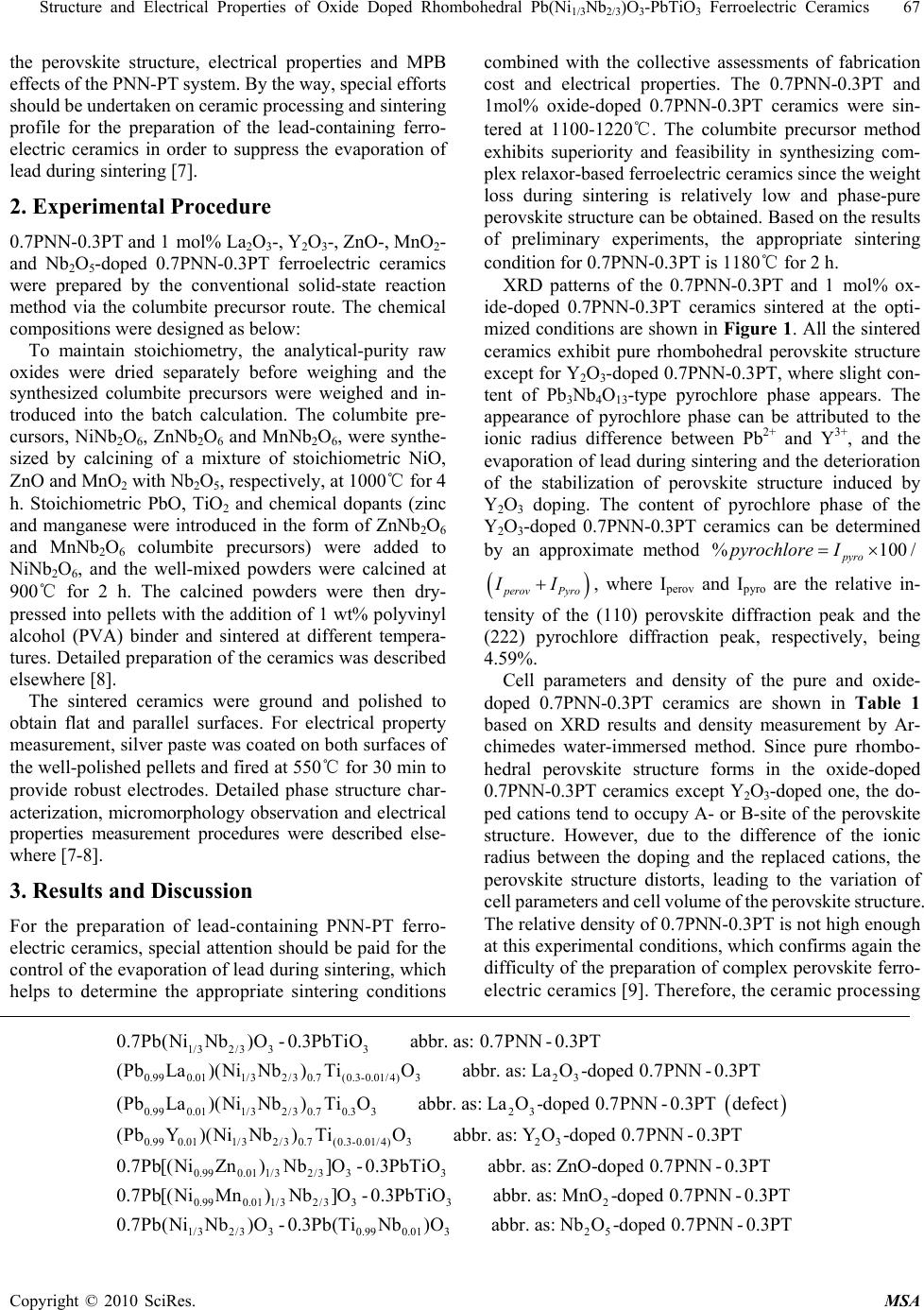
Structure and Electrical Properties of Oxide Doped Rhombohedral Pb(NiNb )O -PbTiO Ferroelectric Ceramics 67
1/32/3 3 3
00/
the perovskite structure, electrical properties and MPB
effects of the PNN-PT system. By the way, special efforts
should be undertaken on ceramic processing and sintering
profile for the preparation of the lead-containing ferro-
electric ceramics in order to suppress the evaporation of
lead during sintering [7].
2. Experimental Procedure
0.7PNN-0.3PT and 1 mol% La2O3-, Y2O3-, ZnO-, MnO2-
and Nb2O5-doped 0.7PNN-0.3PT ferroelectric ceramics
were prepared by the conventional solid-state reaction
method via the columbite precursor route. The chemical
compositions were designed as below:
To maintain stoichiometry, the analytical-purity raw
oxides were dried separately before weighing and the
synthesized columbite precursors were weighed and in-
troduced into the batch calculation. The columbite pre-
cursors, NiNb2O6, ZnNb2O6 and MnNb2O6, were synthe-
sized by calcining of a mixture of stoichiometric NiO,
ZnO and MnO2 with Nb2O5, respectively, at 1000℃ for 4
h. Stoichiometric PbO, TiO2 and chemical dopants (zinc
and manganese were introduced in the form of ZnNb2O6
and MnNb2O6 columbite precursors) were added to
NiNb2O6, and the well-mixed powders were calcined at
900℃ for 2 h. The calcined powders were then dry-
pressed into pellets with the addition of 1 wt% polyvinyl
alcohol (PVA) binder and sintered at different tempera-
tures. Detailed preparation of the ceramics was described
elsewhere [8].
The sintered ceramics were ground and polished to
obtain flat and parallel surfaces. For electrical property
measurement, silver paste was coated on both surfaces of
the well-polished pellets and fired at 550℃ for 30 min to
provide robust electrodes. Detailed phase structure char-
acterization, micromorphology observation and electrical
properties measurement procedures were described else-
where [7-8].
3. Results and Discussion
For the preparation of lead-containing PNN-PT ferro-
electric ceramics, special attention should be paid for the
control of the evaporation of lead during sintering, which
helps to determine the appropriate sintering conditions
combined with the collective assessments of fabrication
cost and electrical properties. The 0.7PNN-0.3PT and
1mol% oxide-doped 0.7PNN-0.3PT ceramics were sin-
tered at 1100-1220℃. The columbite precursor method
exhibits superiority and feasibility in synthesizing com-
plex relaxor-based ferroelectric ceramics since the weight
loss during sintering is relatively low and phase-pure
perovskite structure can be obtained. Based on the results
of preliminary experiments, the appropriate sintering
condition for 0.7PNN-0.3PT is 1180℃ for 2 h.
XRD patterns of the 0.7PNN-0.3PT and 1 mol% ox-
ide-doped 0.7PNN-0.3PT ceramics sintered at the opti-
mized conditions are shown in Figure 1. All the sintered
ceramics exhibit pure rhombohedral perovskite structure
except for Y2O3-doped 0.7PNN-0.3PT, where slight con-
tent of Pb3Nb4O13-type pyrochlore phase appears. The
appearance of pyrochlore phase can be attributed to the
ionic radius difference between Pb2+ and Y3+, and the
evaporation of lead during sintering and the deterioration
of the stabilization of perovskite structure induced by
Y2O3 doping. The content of pyrochlore phase of the
Y2O3-doped 0.7PNN-0.3PT ceramics can be determined
by an approximate method
%1
pyro
pyrochlore I
erov Pyro
II, where Iperov and Ipyro are the relative in-
tensity of the (110) perovskite diffraction peak and the
(222) pyrochlore diffraction peak, respectively, being
4.59%.
Cell parameters and density of the pure and oxide-
doped 0.7PNN-0.3PT ceramics are shown in Table 1
based on XRD results and density measurement by Ar-
chimedes water-immersed method. Since pure rhombo-
hedral perovskite structure forms in the oxide-doped
0.7PNN-0.3PT ceramics except Y2O3-doped one, the do-
ped cations tend to occupy A- or B-site of the perovskite
structure. However, due to the difference of the ionic
radius between the doping and the replaced cations, the
perovskite structure distorts, leading to the variation of
cell parameters and cell volume of the perovskite structure.
The relative density of 0.7PNN-0.3PT is not high enough
at this experimental conditions, which confirms again the
difficulty of the preparation of complex perovskite ferro-
electric ceramics [9]. Therefore, the ceramic processing
1/32/3 33
0.990.011/32/3 0.7(0.3-0.01/4)323
0.990.011/32/3 0.70.3323
0.7Pb(NiNb)O-0.3PbTiOabbr. as: 0.7PNN-0.3PT
(PbLa)(NiNb)TiOabbr. as: LaO-doped 0.7PNN-0.3PT
(PbLa)(NiNb)TiOabbr. as: LaO-doped 0.7PNN-0.3PT
0.990.011/32/3 0.7(0.3-0.01/4)323
0.990.01 1/32/333
0.990.011/32/333
defect
(PbY)(NiNb)TiOabbr. as: Y O-doped 0.7PNN-0.3PT
0.7Pb[(NiZn)Nb]O-0.3PbTiOabbr. as: ZnO-doped 0.7PNN-0.3PT
0.7Pb[(NiMn)Nb]O-0.3PbTiOab2
1/32/330.990.0132 5
r. as: MnO-doped 0.7PNN-0.3PT
0.7Pb(NiNb)O-0.3Pb(TiNb)Oabbr. as: NbO-doped 0.7PNN-0.3PT
Copyright © 2010 SciRes. MSA